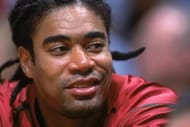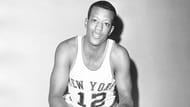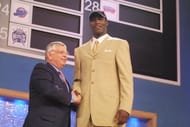Markelle Fultz is having a nightmare start to his NBA career. A wrecked shoulder and loss of confidence have seen the Number 1 overall pick of the 2017 NBA Draft struggle mightily in the NBA thus far.
Some have already put forward claims that he is the biggest draft bust of all time, but I'd like to pump the breaks on that one. Fultz has got a couple more years to prove his worth, but his situation got us thinking about who is actually the biggest bust of all time among the Number 1 overall picks.
In this article, we'll rewind the clock and try to rank the guys who just couldn't get the job done in the NBA. We'll be ranking these guys based on their play of course, but also on who the team potentially missed out on by drafting them. So, here's the top 10:
#10. Pervis Ellison 1989

Explore the NBA Draft 2024 with our free NBA Mock Draft Simulator & be the GM of your favorite NBA team.
Never Nervous Pervis in college became Out of Service Pervis when he came into the NBA with the Kings. Ellison played just 32 games his rookie year and was traded to Washington soon after. Ellison enjoyed the best years of his career with the Bullets and had the best year by far of any player on this list in 1991/92, where he averaged 20 Points and 11.2 Rebounds per game, winning Most Improved Player.
That would be the high point of his career, as it was all downhill post that season, as injuries began taking their toll on his body. Ellison finished his career with averages of 9.5 Points and 6.7 Rebounds.
A point can be made that if not for those injuries, he might have actually ended up having a pretty good NBA career, as evidenced by that 1991/92 season, but alas it didn't last. The Kings missed out on some great players in that draft, in Shawn Kemp, Glen Rice, and Tim Hardaway.
#9 Art Heyman 1963

Art Heyman was a star in college for Duke. A terrific scorer, he's widely regarded as the guy who put the college on the map, as they weren't the force they are known as today before his arrival. His exploits at Duke led to him being drafted 1st overall in the 1963 draft by the New York Knicks.
Heyman had an instant impact, averaging 15.4 Points and was voted into the NBA All-Rookie team. You'd think he'd kick on from there, but temper issues and outbursts meant that his playing time was cut down significantly.
He was out of New York soon after and was out of the league by 1966. Heyman did ultimately end up having success in the ABA, which he joined in 1967, but just in the NBA terms, he remains one of the biggest busts. He finished his NBA career, averaging 10.2 Points and 2.3 Rebounds. Hall of Famers Nate Thurmond and Gus Johnson were drafted after Heyman.
#8. Kent Benson 1977

After 4 solid years in College at Indiana, Kent Benson was drafted by the Milwaukee Bucks in 1977. Benson came to a franchise that had lost Kareem Abdul-Jabbar in 1975 and was in desperate need of a new superstar.
In his very first game, he ended up having an altercation, ironically with Jabbar, which left him with a broken jaw. He ended his rookie season averaging 7.7 Points and 4.3 Rebounds. It didn't get much better as the years went by, and Benson finished his career averaging 9.1 Points and 5.7 Rebounds.
What we've seen over time is that teams which got rid of Benson ended up getting better. The Bucks traded him away to the Pistons for Bob Lanier in 1980 and reached multiple Eastern Conference Finals in the coming years. The Pistons then traded him away in 1986 for Adrian Dantley and had their most successful spell as a franchise.
The Bucks missed out on Hall of Famer Bernard King in the 1977 draft, who would have given the franchise a much-needed boost.
#7. Bill McGill 1962

Bill McGill was an absolute beast in college, as he averaged 38.8 Points which led the nation in scoring and it was also the 2nd highest scoring average in college basketball history. This led to the Chicago Zephyrs picking him First in the 1962 NBA draft and it ended up becoming an unmitigated disaster.
McGill was shipped out of Chicago after his rookie season, and by 1965 he was out of the league. McGill would play in the ABA for 2 seasons, after which he was out of professional basketball altogether and by the time the 70s came around, McGill was on the streets.
His NBA career averages were 10.2 Points and 3.9 Rebounds. Three Hall of Famers were drafted after McGill, as Zelmo Beaty went 3rd, John Havlicek went 7th and Chet Walker would go 12th.
#7 Sihugo Green 1956

One of the lesser-known busts in NBA history, Sihugo Green has somehow gotten lost when it comes to this topic and that is very surprising, considering who else was in that draft. Green had a solid college career, averaging 24 Points a game his final year, which led to the Rochester Royals drafting him Number 1 Overall in 1956, a move which seems acceptable on paper, but dive a bit deeper, and it's baffling.
The Royals passed on Bill Russell to draft Green and one can only imagine how different NBA history would have been, had the Royals drafted Russell. Russell was the greatest college basketball player in history by the time he joined the NBA and there was no way Green should have gone ahead of him.
For his career, Green averaged 9.2 Points and 4.3 Rebounds, while I don't really need to say anything about Russell. The Royals missed out on another Celtic great in that draft, in K.C.Jones.
#6 Kwame Brown 2001

It's safe to say that Kwame Brown is the most popular player on this list. The poster child of draft busts, Brown came out of High School with a lot of expectations. Consistently rated as the best high school player of his draft class, his performances convinced the Washington Wizards to pick him Number 1 in 2001.
He underwhelmed in his rookie season, but that was expected from a guy who was that young. Brown improved in the following years, but injuries and feuds with teammates and coaches meant he was shipped out soon enough to the Lakers.
Brown became somewhat of a laughing stock with the team and was traded away in 2008 for Pau Gasol, a move which would propel the Lakers back to Championship contention. Brown would bounce around the league for a few more years before ending his career with averages of 6.6 Points and 5.5 Rebounds. As for the guys the Wizards missed out on, Pau Gasol ironically went 3rd while Tony Parker went 28th.
#4 Greg Oden 2007

One of the biggest busts in recent time, Greg Oden was a lock to be an NBA superstar. A dominant big man, especially on the defensive end, Oden flourished in college and was supposed to be the next great big in the NBA.
His physical prowess made him a no-brainer for many when compared to his main rival for that top spot in Kevin Durant, who many people considered too skinny to succeed in the NBA. This led to the Blazers drafting Oden number 1 in the 2007 draft.
Unfortunately for the Blazers and Oden, he got injured before his rookie season and the injury nightmare never ended. Oden would miss his entire rookie season and play just 82 games over his next 2 seasons after which he wouldn't play an NBA game till 2013.
A brief stint with the Heat lasted just 26 games, after which Oden was out of the league. His NBA career averages stood at 8 Points and 6.2 Rebounds. As mentioned before, the Blazers passed on KD for Oden and they also missed out on Joakim Noah and Marc Gasol.
#3 Michael Olowokandi 1998

Michael OIowokandi was hailed as the next Hakeem Olajuwon coming into the NBA. Let that sink in for a moment. There were some similarities sure, they were both from Lagos in Nigeria and were quick on their feet for a big, but that's about it.
The Clippers were a dumpster fire during the late 90s and early 2000s and drafting the Kandi Man was another example. Drafted 1st overall in 1998, Olowokandi was a decent player for the Clippers for a couple of years and nothing more, after which injuries basically ended his career as a productive player.
Olowokandi's career averages were 8.3 Points and 6.3 Rebounds. What ranks Olowokandi over Oden in this ranking is based on who the Clippers missed out on, as Vince Carter, Paul Pierce, and Dirk Nowitzki, 3 sure shot future Hall of Famers would all go in the top 10 in 1998.
#2 LaRue Martin 1972

Three of the biggest busts in NBA history have somehow all been drafted by the Trail Blazers. While the Oden and Sam Bowie picks can be excused due to injuries, the Martin pick was just horrible.
Martin shot to National attention when he outplayed Bill Walton in their college matchup, which apparently convinced the Blazers to pick him Number 1. As a rookie, Martin averaged 4.4 Points and 4.6 Rebounds.
He didn't show a great deal of improvement the following seasons and the Blazers would draft Walton in 1974, which all but ended any hopes Martin had of succeeding with the team. He was traded to Seattle in 1976, but retired before the season began.
All in all, Martin played just 4 years in the league and averaged 5.3 Points and 4.6 Rebounds. He was drafted ahead of Hall of Famer Bob McAdoo as well as Julius Erving, but Erving opted to join the ABA, so it probably wouldn't have worked out anyway.
#1 Anthony Bennett 2013

While LaRue takes the crown for most people, I'd say Anthony Bennett is the biggest bust in NBA history. Bennett had a decent year at college, but nobody including the man himself expected him to go Number 1 in 2013.
Some analysts even had Bennett out of the top 10, so the pick was really perplexing. Unsurprisingly, Bennett didn't even come close to meeting expectations. He averaged 4.2 Points and 3 Rebounds as a rookie and it took him 33 games to even hit double figures in points in a game.
He'd be traded to the Timberwolves the following year and after spending 2 more seasons in the NBA, Bennett was out of the league. His NBA averages thus far portray a sorry story, averaging 4.4 Points and 3.1 Rebounds. He's currently playing in the G-League and is hoping to get another shot in the NBA.
As for who the Cavs missed out on, Victor Oladipo went 2nd, C.J.McCollum went 10th, Giannis was 15th and Rudy Gobert ended up 27th. Considering the sheer amount of talent that was left in that draft, I'd pick Bennett to be the worst Number 1 draft pick of all time.
Washington Wizards Nation! You can check out the latest Washington Wizards Schedule and dive into the Wizards Depth Chart for NBA Season 2024-25.